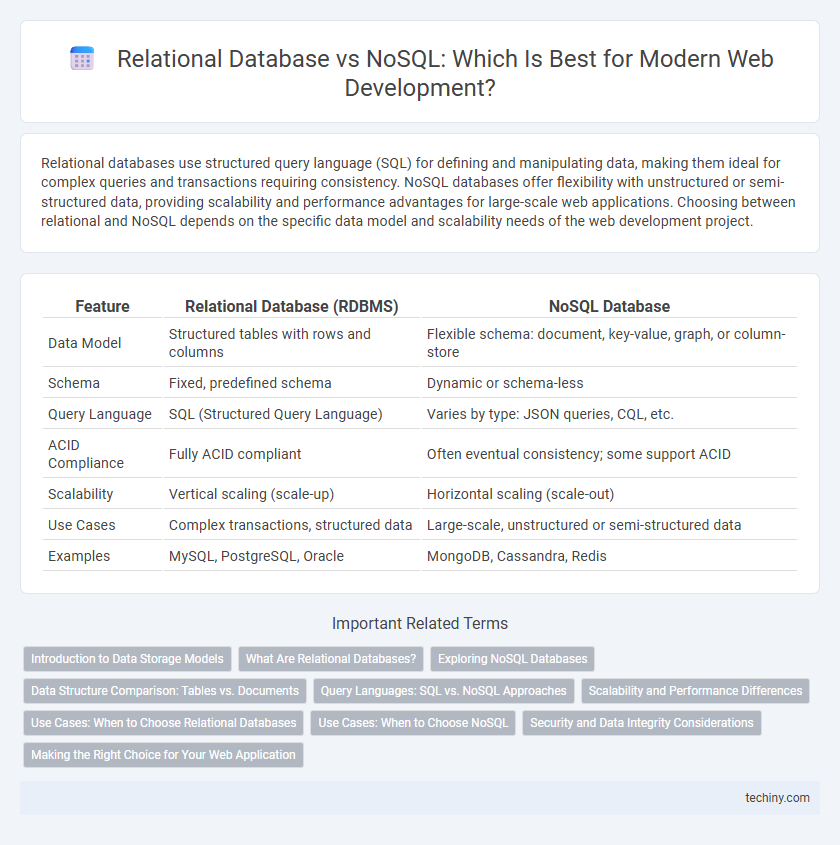Relational databases use structured query language (SQL) for defining and manipulating data, making them ideal for complex queries and transactions requiring consistency. NoSQL databases offer flexibility with unstructured or semi-structured data, providing scalability and performance advantages for large-scale web applications. Choosing between relational and NoSQL depends on the specific data model and scalability needs of the web development project.
Table of Comparison
| Feature | Relational Database (RDBMS) | NoSQL Database |
|---|---|---|
| Data Model | Structured tables with rows and columns | Flexible schema: document, key-value, graph, or column-store |
| Schema | Fixed, predefined schema | Dynamic or schema-less |
| Query Language | SQL (Structured Query Language) | Varies by type: JSON queries, CQL, etc. |
| ACID Compliance | Fully ACID compliant | Often eventual consistency; some support ACID |
| Scalability | Vertical scaling (scale-up) | Horizontal scaling (scale-out) |
| Use Cases | Complex transactions, structured data | Large-scale, unstructured or semi-structured data |
| Examples | MySQL, PostgreSQL, Oracle | MongoDB, Cassandra, Redis |
Introduction to Data Storage Models
Relational databases organize data into structured tables with predefined schemas, supporting complex queries through SQL and ensuring data integrity via ACID compliance. NoSQL databases employ flexible, schema-less models such as document, key-value, column-family, or graph formats, optimizing for scalability and handling unstructured or semi-structured data. Understanding these fundamental differences helps developers choose the appropriate data storage model based on the application's requirements for consistency, scalability, and data complexity.
What Are Relational Databases?
Relational databases organize data into structured tables with predefined schemas, enabling complex queries using SQL (Structured Query Language). They ensure data integrity through relationships, primary keys, and constraints, making them ideal for transactional systems requiring consistency. Popular relational database management systems include MySQL, PostgreSQL, and Oracle Database.
Exploring NoSQL Databases
NoSQL databases offer flexible schema designs ideal for handling unstructured and semi-structured data, making them suitable for applications requiring rapid iteration and scalability. They support diverse data models such as document, key-value, column-family, and graph, enabling optimized performance for specific use cases like real-time analytics and content management. Popular NoSQL databases like MongoDB, Cassandra, and Redis provide high availability and horizontal scaling, essential for modern web development demands.
Data Structure Comparison: Tables vs. Documents
Relational databases organize data into structured tables with predefined schemas, enabling complex JOIN operations and ensuring data integrity through relationships and constraints. NoSQL databases store information in flexible document formats, such as JSON or BSON, allowing for hierarchical data models and dynamic schemas that adapt to varying data types. Tables provide consistency and clear connections across datasets, while document stores excel in scalability and handling unstructured or semi-structured data.
Query Languages: SQL vs. NoSQL Approaches
SQL query language in relational databases uses structured syntax optimized for complex joins and transactions, ensuring data integrity through ACID compliance. NoSQL databases employ diverse query mechanisms, such as document-based queries, key-value lookups, and graph traversals, designed for scalability and flexible schema evolution. Query performance varies significantly based on data model and use case, with SQL excelling in relational data consistency and NoSQL providing optimized retrieval for unstructured or semi-structured data.
Scalability and Performance Differences
Relational databases use structured schemas and SQL queries, ensuring strong consistency but often facing scalability challenges with large, distributed systems. NoSQL databases provide flexible schemas and horizontal scaling, enabling high performance and efficient management of unstructured data across multiple nodes. For applications requiring massive data throughput and agile scaling, NoSQL typically outperforms relational databases in handling large-scale workloads.
Use Cases: When to Choose Relational Databases
Relational databases excel in use cases requiring complex queries, data integrity, and transaction consistency, such as financial systems and inventory management. They are ideal for structured data with clear relationships, leveraging SQL for precise data retrieval and enforcement of relational constraints. Use relational databases when ACID compliance, referential integrity, and multi-row transactions are critical to application functionality.
Use Cases: When to Choose NoSQL
NoSQL databases are ideal for handling large volumes of unstructured or semi-structured data such as social media feeds, real-time analytics, and IoT applications where rapid scalability and flexible schemas are essential. They excel in scenarios requiring horizontal scaling across distributed systems, offering high availability and fault tolerance for big data and real-time web applications. When dealing with dynamic data models or rapidly evolving datasets, NoSQL provides the adaptability that traditional relational databases lack.
Security and Data Integrity Considerations
Relational databases enforce strict schema and ACID (Atomicity, Consistency, Isolation, Durability) compliance, ensuring robust data integrity and secure transaction management essential for sensitive information. NoSQL databases offer flexible schemas and scalability but often sacrifice strong consistency guarantees, posing challenges for enforcing data integrity and requiring additional security measures like encryption and access controls. Careful evaluation of application requirements and security compliance standards is critical when choosing between relational and NoSQL databases in web development.
Making the Right Choice for Your Web Application
Relational databases use structured schemas and SQL queries, providing strong consistency and complex transaction support, ideal for applications requiring multi-table joins and ACID compliance. NoSQL databases offer flexible data models like document, key-value, or graph stores, excelling in horizontal scalability and rapid development for unstructured or semi-structured data. Choosing the right database depends on your web application's data complexity, scalability needs, and consistency requirements, ensuring optimal performance and maintainability.
Relational Database vs NoSQL Infographic

 techiny.com
techiny.com